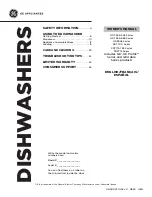
2
EN
Positioning and levelling
1. Remove the appliance from all packaging and
check that it has not been damaged during
transportation.
If it has been damaged, contact the retailer and do not
proceed any further with the installation process.
2. Check the dishwasher by placing it so that its sides
or back panel are in contact with the adjacent
cabinets or even with the wall. This appliance can also
be recessed under a single worktop (
see the
Assembly instruction sheet).
3. Position the dishwasher on a level and sturdy floor. If
the floor is uneven, the front feet of the appliance may
be adjusted until it reaches a horizontal position (the
angle of inclination must not exceed 2 degrees). If the
appliance is levelled correctly, it will be more stable
and much less likely to move or cause vibrations and
noise while it is operating.
!
Keep this instruction manual in a safe place for
future reference. If the appliance is sold, given away
or moved, please ensure the manual is kept with the
machine, so that the new owner may benefit from the
advice contained within it.
!
Please read this instruction manual carefully: it
contains important information regarding the safe
installation, use and maintenance of the appliance.
!
If the appliance must be moved at any time, keep it
in an upright position; if absolutely necessary, it may
be tilted onto its back.
Connecting the water outlet hose
Connect the outlet hose
(without bending it) to a
drain duct with a minimum
diameter of 4 cm.
Alternatively, rest it over a
sink or tub; the free end of
the hose should not
remain immersed in water.
The special plastic elbow*
makes it easier to find the best layout: fix the elbow to
the wall securely in order to prevent the outlet hose
from moving and spilling the dirty water.
The part of the hose marked with the letter A should
be between 40 and 100 cm above the ground (
see
figure).
!
We advise against the use of hose extensions.
A
Advice regarding the first wash cycle
After the appliance has been installed, immediately
before running the first wash cycle, completely fill the
salt dispenser with water and add approximately 2 kg
of salt (
see Rinse aid and refined salt). The water may
overflow: this is normal and is not a cause for
concern. It is also normal that the LOW SALT*
indicator light continues to flash for a few cycles after
the salt has been loaded.
* Only available in selected models.
7HFKQLFDOGDWD
'LPHQVLRQV
width 60 cm
height 85 cm
depth 60 cm
&DSDFLW\
12 standard place-settings
:DWHUVXSSO\
SUHVVXUH
30 KPa ÷ 1 MPa (0,3 ÷ 10 bar)
3RZHUVXSSO\
YROWDJH
See appliance data plate
7RWDO
DEVRUEHG
SRZHU
See appliance data plate
)XVH
See appliance data plate
This dishwasher conforms to
the following European
Community Directives:
-73/23/EEC dated 19/02/73
(Low Voltage) and subsequent
modifications
-89/336/EEC dated 03/05/89
(Electromagnetic Compatibility)
and subsequent modifications)
-97/17/EC (Labelling)
- 2002/96/EC(WEEE)
Installation
Summary of Contents for FDW 70
Page 19: ...19 EN Notes ...



































